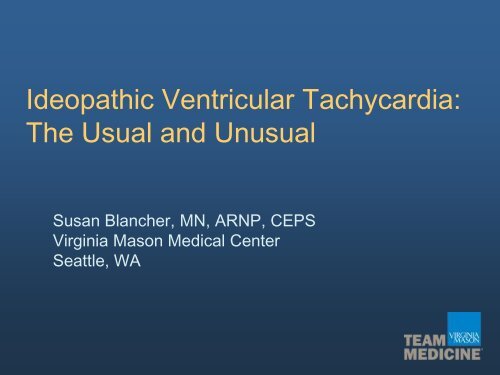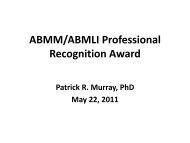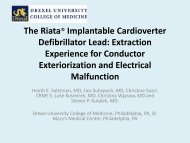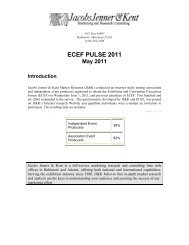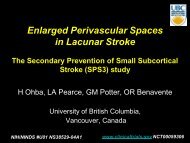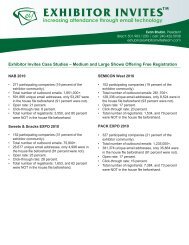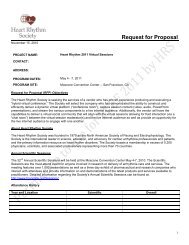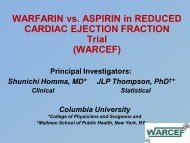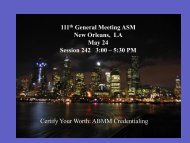Ideopathic Ventricular Tachycardia: The Usual and Unusual
Ideopathic Ventricular Tachycardia: The Usual and Unusual
Ideopathic Ventricular Tachycardia: The Usual and Unusual
You also want an ePaper? Increase the reach of your titles
YUMPU automatically turns print PDFs into web optimized ePapers that Google loves.
<strong>Ideopathic</strong> <strong>Ventricular</strong> <strong>Tachycardia</strong>:<br />
<strong>The</strong> <strong>Usual</strong> <strong>and</strong> <strong>Unusual</strong><br />
Susan Blancher, MN, ARNP, CEPS<br />
Virginia Mason Medical Center<br />
Seattle, WA
© 2012 Virginia Mason Medical Center
Sustained <strong>Ventricular</strong> <strong>Tachycardia</strong>s<br />
• Polymorphic VT<br />
Acute ischemia<br />
Abnormalities of ion channels (long/short QT, Brugada, CPMVT)<br />
Idiopathic ventricular fibrillation<br />
Structural heart disease: (Hypertrophy, recent MI, Cardiomyopathy)<br />
• Monomorphic VT<br />
Scar-related reentry (Cardiomyopathies: idiopathic, viral, sarcoid,<br />
Chagas, aneurysms, ARVD; previous MI, surgical scar)<br />
Purkinje Disease (BBRT, automaticity)<br />
Idiopathic VT<br />
• Outflow Tract: RVOT, LVOT<br />
• Left fascicular VT (Belhassen’s VT)<br />
© 2012 Virginia Mason Medical Center
Definition <strong>and</strong> Classification<br />
• <strong>Ideopathic</strong>: “Cause Unknown”<br />
• “VT in the absence of apparent structural HD”<br />
• Multiple classification schemes (presentation,<br />
ECG, mechanism, response to meds,<br />
ventricular origin) has led to confusion<br />
• Current use : MMVT, absence of structural<br />
heart disease, benign syndrome<br />
• Excludes disorders associated with SCD
<strong>Ideopathic</strong> VT<br />
I. Outflow Tract VT<br />
A. RVOT: Pulmonary Artery to His region<br />
B. LVOT: Aortic cusps, Aortomitral continuity,<br />
Epicardial, Mitral Annulus<br />
II. LV Fascicular VT<br />
A. Posterior fascicular<br />
B. Anterior fascicular<br />
C. Upper septal
Distribution of VT<br />
Total VT = 90% structural heart disease, 10% ideopathic<br />
N = 122 undergoing ablation for IVT 1999-2003<br />
• RVOT : 88 (72%)<br />
• LVOT: 20 (16%) ( 9 aortic cusps, 11 basal LV endocardium)<br />
• Fascicular VT : 14 (11%)<br />
Structural<br />
Heart<br />
Disease<br />
(90%)<br />
<strong>Ideopathic</strong> (10%)<br />
RVOT (72%)<br />
LVOT (16%)<br />
FVT(11%)<br />
Dixit S, Lin D, Zado E., Heart Rhythm 1:S104m 2004
Outflow Tract VT
Symptoms <strong>and</strong> Presentation<br />
• 70% RVOT are female; 70% LVOT are male<br />
• Early age : 20-50 years<br />
• Frequent PVC’s, Salvos of VT, or sustained VT<br />
• Symptoms include palpitations <strong>and</strong> lightheadedness,<br />
dyspnea, CP, syncope<br />
• Often provoked by exercise, stress, anxiety, stimulants,<br />
hormonal trigger in females, PVC’s <strong>and</strong> salvos can<br />
occur at rest or recovery from exercise, circadian pattern<br />
• Lack of structural heart disease is the rule, subtle<br />
abnormalities may be present
Relationship of Heart Rate to Frequency of<br />
Ectopy From 3 Representative Patients<br />
Kim, RJ. et al. J Am Coll Cardiol 2007;49:2035-2043<br />
Copyright ©2007 American College of Cardiology Foundation. Restrictions may apply.<br />
Heart rate<br />
# PVCs<br />
VT runs
Identical Morphologies of PVCs, NSVT,<br />
<strong>and</strong> Sustained VT From a Patient With<br />
Exercise-Induced VT<br />
Kim, RJ. et al. J Am Coll Cardiol 2007;49:2035-2043<br />
Copyright ©2007 American College of Cardiology Foundation. Restrictions may apply.
Mechanism of Outflow Tract VT<br />
Delayed Afterdepolarizations
Anatomy of Cardiac Myocyte
Calcium Overload causes DAD’s<br />
1. Activation of beta-receptor (epi,<br />
isuprel)<br />
2. G- protein stimulation<br />
3. Adenylate cyclase stimulation<br />
4. Increase of cAMP (via ATP)<br />
5. PKA activation<br />
6. Increase intracellular Calcium<br />
from SR <strong>and</strong> L channels<br />
7. Increase transient Na influx via<br />
Na/CaX<br />
8. Results in delayed<br />
afterdepolarization<br />
9. If reaches threshold sets off AP<br />
<strong>and</strong> triggered arrhythmia<br />
I Ca(L)<br />
Ca 2+<br />
First messenger<br />
SR<br />
Signal molecule<br />
(such as epinephrine)<br />
GTP<br />
G protein<br />
Ca 2+<br />
©1999 Addison Wesley Longman, Inc. (adapted)<br />
ATP<br />
Adenyl<br />
cyclase<br />
cAMP<br />
Protein<br />
kinase A<br />
Na<br />
Na/CaX<br />
Second<br />
Messenger<br />
cAMP dependant Calcium Overload is<br />
Generated which leads to DAD via Na-CaX
Normal Action Potential<br />
Copyright ©1999 <strong>The</strong> American Association for Thoracic Surgery
DAD’s <strong>and</strong> Triggered Beats
RVOT VT Origin<br />
• 70-80% septal<br />
• 20-30% freewall<br />
• Majority are septal,<br />
just below Pulmonary<br />
Valve, anterior<br />
• Can be above<br />
Pulmonary valve<br />
• Can be low, near HIS
Case Study: RVOT VT<br />
• 37 year old female pediatrician<br />
• Long history of asymptomatic but frequent PVC’s<br />
• Recent near syncopal event while skiing<br />
(no family hx of syncope or sudden death)<br />
• In ED very frequent unifocal PVC’s<br />
• EF 50-55% normal echo, MRI r/o ARVC, negative stress<br />
test<br />
• 24 hour holter : 27% PVC’s (27,000/24hr)<br />
• ECG: PVC morphology LBBB, inferior axis. Otherwise<br />
normal.<br />
• Trial of Beta Blockers, intolerant SE, wants ablation
LBBB, Inferior Axis<br />
RVOT
Mapping <strong>and</strong> Ablation of RVOT VT<br />
• Keep sedation light<br />
• A pace to r/o preexcitation, SVT w/ aberrancy,<br />
<strong>and</strong> induce VT<br />
• V pace to induce VT to r/o other VT/VF<br />
• Isuprel infusion to induce VT<br />
• Activation mapping: target earliest site: 10-60 ms<br />
before QRS onset<br />
• Pace mapping: 12/12 lead perfect match (can be<br />
up to 2cm away)<br />
• Unipolar: sharp QS
Mapping <strong>and</strong> Ablation of RVOT (cont)<br />
• 4mm tip electrode, can be irrigated, avoid high temps, 80%, failure usually due to inability to<br />
induce
Earliest Activation Site
RAO<br />
ablation
LAO<br />
ablation
Termination of VT During Ablation
RVOT Ablation Site
RVOT Ablation Site
© 2012 Virginia Mason Medical Center
24 Hour Holter PVC’s<br />
"lower group" 20% extrasystoles<br />
>20% (20,000 beats/day) associated with:<br />
Enlarged LV dimension<br />
Reduced LV EF<br />
Increased MR<br />
NYHA Functional Class decrease<br />
Dramatic improvement to baseline after ablation<br />
Takemoto, et al JACC 2005.
LVOT VT<br />
• Aortic cusps<br />
• Aortomitral<br />
continuity (AMC)<br />
• Peri-Mitral region<br />
• Epicardial
Aortic Sinus<br />
Cusps<br />
ECG morphology:<br />
Broad R-wave in V1, V2<br />
Transition
Ablator in Left Aortic Cusp
Left Aortic Cusp Early Potential
Aortic-mitral Continuity
AMC VT<br />
12/12 pace map Earliest site
Ablation at AMC Site
Complications of<br />
Outflow Tract VT Ablation<br />
• RVOT: perforation <strong>and</strong> tamponade, heart block<br />
• LVOT: perforation <strong>and</strong> tamponade, heart block,<br />
MI if ablate near coronary artery (aortic cusp VT),<br />
injury to aortic cusp
LAF<br />
Left Fascicular VT<br />
LPF<br />
• Posterior fascicle<br />
• Anterior fascicle<br />
• Upper septal
Presentation <strong>and</strong> Symptoms<br />
• Exercise related VT<br />
• Verapamil sensitive<br />
• Ages 15-40 years<br />
• 60-80% males<br />
• <strong>Usual</strong>ly paroxysmal, but can be incessant <strong>and</strong> lead to<br />
tachycardiomyopathy<br />
• No structural abnormality<br />
• RBBB, LAD in 90% (LPF VT), RBBB, RAD (LAF VT)<br />
10%, upper septal
• macroreentry<br />
Mechanism of LV VT
LPF VT Circuit<br />
P1 P2<br />
Ramprakash et al. Indian Pacing <strong>and</strong> Electrophysiology 2008
Successful Ablation Sites of Left<br />
Posterior Fascicular VT<br />
Nakagawa: early Purkinje<br />
Potentials (P2) distal site<br />
Nogami, PACE 2011<br />
Tsuchiya: diastolic potentials<br />
(P1) proximal mid-septum
Nagami A, Pace 2011
Nogami, PACE 2011<br />
LPF <strong>and</strong> LAF VT Circuits<br />
Antegrade limbs of LPF<br />
<strong>and</strong> LAF VT are abnormal<br />
midseptal purkinje tissue
RBBB, LAD<br />
Left posterior fascicular VT<br />
Left anterior fascicular VT<br />
RBBB, RAD RAD, RBBB
Case Study LV VT<br />
• 20 year old male presented to urgent care<br />
for evaluation of scabies, otherwise no<br />
complaints<br />
• HR 108, ECG showed VT<br />
• Entirely asymptomatic<br />
• Echo: EF 36%, LV dilated<br />
• Incessant VT for unknown duration<br />
• VT morphology: RBBB, LAD
RB/ LAD: Left fascicular VT<br />
(posterior)
ECG of Case Study VT Rate 101 bpm
AV Dissociation in VT<br />
P waves
Map Catheter in LV<br />
Against Apical Septum<br />
(P1)<br />
(P2)
Left Fascicular VT – Posterior Fascicle<br />
LAO<br />
ablate
His<br />
RAO<br />
ablate
Left Fasicular VT
Left fascicular VT ablation site<br />
ablation
Lin, D, et al. HR 2005<br />
Linear Ablation of LV VT
Nogami, PACE 2011<br />
Upper Septal VT Circuit<br />
© 2012 Virginia Mason Medical Center<br />
Antegrade limbs are<br />
LAF <strong>and</strong> LPF<br />
Retrograde limbs are<br />
abnormal midseptal<br />
purkinje tissue
Upper Septal Fascicular VT<br />
Narrow QRS,<br />
Normal axis<br />
or RAD<br />
© 2012 Virginia Mason Medical Center
Complications of LV VT Ablation<br />
• AV Block<br />
• LBBB
Summary<br />
1.Outflow Tract VT: focal, DAD’s, adenosine<br />
sensitive, earliest site is target<br />
RVOT VT - most common<br />
LVOT VT - can be difficult to ablate, higher risk of<br />
complication<br />
2.Left Fascicular VT: macroreentry, verapamil<br />
sensitive, ablate any P1, earliest P2, or linear<br />
ablation<br />
LPF VT - most common<br />
LAF VT - infrequent<br />
Upper septal VT - rare


